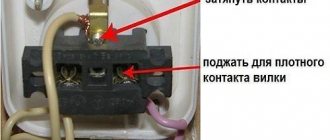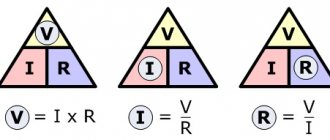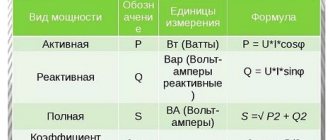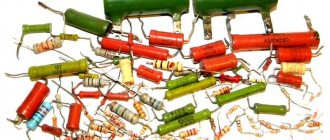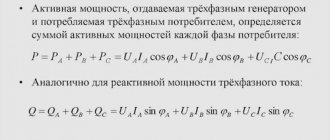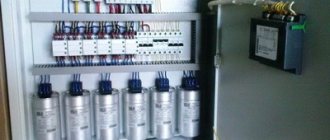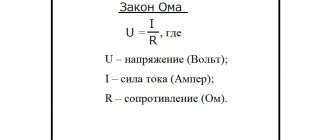To select the cross-section of power cables and wires when laying electrical networks for consumers, you need to know what power devices will be included in them. You can learn how to calculate the power consumption of an electrical appliance by understanding the very concept of power. For this, information from the school curriculum and basic concepts about current, voltage, and resistance will be enough. In addition, this knowledge is needed when purchasing household electrical appliances.
Electric current power
Total power and its components
Electrical power is a quantity responsible for the rate of change or transmission of electricity. The total power is denoted by the letter S and is found as the product of the effective values of current and voltage. Its unit of measurement is volt-ampere (VA; V A).
Total power can consist of two components: active (P) and reactive (Q).
Active power is measured in watts (W; W), reactive power is measured in vars (Var).
It depends on what type of load is included in the electricity consumption circuit.
Active load
This type of load is an element that resists electric current. As a result, the current does the work of heating the load, and the electricity is converted into heat. If a resistor of any resistance is connected in series to a battery, then the current passing through the closed circuit will heat it until the battery is discharged.
Attention! An example of a thermal electric heater (TEH) can be given as an active load in AC networks. The heat generated on it is the result of the work of electricity.
Similar consumers also include spirals of light bulbs, electric stoves, ovens, irons, and boilers.
Capacitive load
Such loads are devices that can accumulate energy in electric fields and create movement (oscillation) of power from source to load and back. Capacitors, cable lines (capacitance between conductors), capacitors and inductors connected in series and parallel in a circuit serve as capacitive loads. Sound power amplifiers and synchronous electric motors in overexcited mode also load the lines with a capacitive component.
Inductive load
When the consumer of electricity is certain equipment, which includes:
- transformers;
- three-phase asynchronous motors, pumps.
On the plates attached to the equipment you can see such a characteristic as cos ϕ. This is the phase shift coefficient between current and voltage in the alternating current network into which the equipment will be connected. It is also called the power factor; the closer cos ϕ to unity, the better.
Important! When a device contains inductive or capacitive components: transformers, chokes, windings, capacitors, the sinusoidal current lags in phase with the voltage by a certain angle. Ideally, the capacitance provides a phase shift of -900, and the inductance provides a phase shift of +900.
Cos ϕ values depending on the type of load
The capacitive and inductive components together form reactive power. Then the total power formula looks like:
S = √ (P2 + Q2),
Where:
- S – apparent power (VA);
- P – active part (W);
- Q – reactive part (Var).
If we display this graphically, then we can see that the vector addition of P and Q will be the total value of S - the hypotenuse of the power triangle.
Graphic explanation of the meaning of total power
Energy consumption of an electric heating system
The heat supply to a private cottage or SNT house is organized by a central electric boiler. This device is often used by owners of small houses. The cost of an induction device is affected by the following indicators:
- Characteristics of the electric boiler. These include the power of the product, operating time, number of circuits, and tank volume.
- Characteristics of the heating circuit. Number of media, their types and individual parameters.
- Building parameters. Number of rooms, area, wall and floor material, quality of thermal insulation.
- Climatic conditions and time of year.
The calculation of electricity consumption is carried out according to the following model:
- The first point is to find out the power of the boiler. Information about this parameter can be found in the device data sheet.
- The power should be multiplied by the number of hours per day that the boiler operates.
- The daily rate is multiplied by the number of days in the month when the boiler is operating. In winter it operates around the clock, and in summer the number of working days can be several units.
- The resulting average daily number is divided in half to take into account the average heat load and power consumption.
You can save money by installing an automated system. It will monitor the operation of the device and the specific energy consumption, and will also use it only in cases where the temperature is below the established norm. The regulating devices are a room thermostat with a programmable controller, which measure the kilowatts used.
Negative effects of reactive load
Learn to easily calculate the power consumption of an electrical appliance
The reactive load does not perform any useful work. Fluctuations in the reactive component from source to consumer only cause parasitic losses. In addition, industrial enterprises are required to pay for the reactive energy supplied to them. This is due to the fact that most energy receivers are electric motors and transformers. The amount of electricity consumed (kWh) does not all go to useful work, but you also need to pay for its reactive component.
Capacitor compensation units will help solve this problem. After all, if you connect a capacitive load in parallel with an inductive load, you can reduce the effect of parasitic currents to a minimum. Such installations are installed at substations supplying consumers.
Formula for calculations
How to calculate electrical energy consumption
All data necessary to be substituted into the formula for calculations can either be measured or taken from the characteristics of the instruments used.
For your information. If the passport data indicates the value of cos ϕ, it means that the electricity received by the device will have a reactive component. This also needs to be taken into account when calculating.
The formula for calculation is:
P = I * U * cos ϕ,
Where:
- I – current in amperes;
- U – voltage in volts;
- cos ϕ – phase shift.
In the case of an active load, the phase shift is not substituted into the formula, and it has the form:
P = I * U.
Refrigerator: 160–550 kWh per year
How much does he spend?
Unlike other equipment, the refrigerator works 24/7 - and this cannot be changed. Therefore, when choosing, it is important to look at two indicators: energy consumption class and annual kWh consumption - these parameters are in the technical specifications.
| Energy class | Average energy consumption per year, kWh | Average cost of energy consumption, rub. |
| A+++ | 160 | 779 |
| A++ | 240 | 1168 |
| A+ | 300 | 1461 |
| A | 350 | 1704 |
| B | 450 | 2191 |
| WITH | 550 | 2678 |
True, there are also situations when even class does not play a decisive role. For example, an A++ refrigerator can burn as much as a class A model - this depends on the volume, number of refrigerators and additional functions.
How to save money
Perhaps the only way to reduce expenses on a refrigerator is to extend its service life. There are some simple tips for this:
- do not install the refrigerator next to the stove
- do not put hot food inside
- defrost in a timely manner - if there is no No Frost function.
The mathematics is simple: if your class A device breaks down and costs 2,000 rubles per year, you can replace it with class A++, which will cost 1,000 rubles per year. But at the same time, you will have to pay at least 30,000 rubles for the purchase itself - and it will only be “repaid” after 30 years.
Features of calculation
To calculate power without having complete data on current and voltage consumption, you can use average characteristics. By consulting reference books, you can find out that lighting equipment can consume current up to 15 A. The maximum current of powerful devices reaches 50-60 A. The power factor, if it is not indicated or known, can be taken as 0.7 - this is the average value.
Single-phase voltage in a household network is 220 V. Its linear value in three-phase networks is 380 V.
Mathematical operations
The basic formula allows you to calculate an unknown quantity when the other two are known. For example, if the current consumed by the device is known I = 2 A and the network voltage U = 220 V, then the power consumption is equal to P = 2 * 220 = 440 W.
For example, it is known that the iron consumes 2 kW, and the voltage in the outlet is 220 V, then you can find the current strength for which the cross-section of the power cord is designed.
I = P/U = 2000/220 = 9.1 A.
In the case of fractional values, when using a calculator for calculations, the obtained values are rounded to tenths of the units of the desired value.
Basic formulas for calculation
What it is
Power is a physical quantity that is equal to the rate at which energy is transmitted or consumed by a system. The second value is the ratio of the work to the period of time during which it was completed.
Most household appliances run on electricity
The power consumption of a household appliance is the amount of electricity that the appliance needs to function. If the device is static (stationary, for example, a telephone, a lamp, a stove), the energy is converted into heat or light, if the device is moving (for example, a motor), the current is converted into mechanical energy.
Correct determination of power is necessary when planning the electrical network, the number of branches and sockets (are additional sockets needed, is it possible to power several devices from one), when choosing circuit breakers, and when determining the cost of electricity (how much current will all devices consume).
Having too many appliances plugged into one outlet can cause a fire.
Rules for calculating power consumption
In everyday life, when the need arises to independently determine the power consumption of electricity, do the following:
- determine the voltage required to power the device;
- find out the rated current from the passport data.
How to find out the power of an electrical appliance if not a single parameter is known? Household electrical appliances are designed for 220 V.
To determine power, it is permissible to measure current consumption. This can be done using an ammeter. It is connected to the circuit in series, having previously set the highest measurement limit - at least a hundred amperes. Current clamp meters will help you easily measure current, for which one of the conductors is grasped by the clamp sensor, and the readings are displayed on the display. Knowing the voltage, multiply it by the measured current to obtain the amount of power consumed.
Clamp meter
Learning to count
When a person counts his own money, he quickly learns how to count correctly. How to calculate how much light was used? There are no big difficulties in this. First, you need to take readings for the past month. The display shows the total consumption, but the payment receipt has three columns - initial readings, final readings and consumption.
The mathematics is simple, you need to subtract the initial readings from the final readings and get the sum of the numbers that determine the monthly consumption. All readings are expressed in units of power consumption per hour - kW/hour. A payment tariff is set for each kW of electricity. To determine the cost, you need to multiply the resulting difference by the cost of 1 kW. The result will be the required amount.
All payment data is entered into the receipt and paid. Payment must be made regularly - once a month, because late payment is subject to penalties.
Calculation of light bulb power
The selection of incandescent lamp power depends on the desired level of illumination of the living space. One 100 W light bulb, working in the dark for at least 12 hours, consumes 1.2 kW of power. For a month this will be 36 kW, for a year - at least 432 kW. If there are 10 light bulbs in an apartment, then the total annual consumption will be 4320 kW. If the price for 1 kW of electricity is 5 rubles, the amount turns out to be decent – 21,000 rubles. Therefore, replacing incandescent lamps with energy-saving light sources: LED lamps, LED strips and the like allows you to save money. In addition, reducing the power of such light bulbs does not reduce the luminous flux. The reduced supply voltage of LED strips also reduces the amount of power consumed.
Electricity consumption for lighting
Lighting is an important part of energy costs that can be reduced. Before calculating the electricity from lamps, you need to find out what kind of light bulbs are used. Classic incandescent lamps require a lot of power to operate and are an economically unprofitable light source. To reduce costs, increase efficiency, efficiency and service life, it is recommended to replace conventional lamps with LED ones. The cost of one product is quite high, but it quickly pays for itself during operation due to its long service life, low electricity consumption and high energy efficiency. In addition, they are completely safe and do not contain harmful components, therefore they are cost-effective for creating a lighting group.
Power measurement devices
To measure P, you can use special instruments. A multimeter is suitable for this, to which you can connect a current clamp. How to measure power with a multimeter? The tester is switched on to the alternating voltage measurement mode; the clamps should grasp only one conductor connected to the load.
Measuring with a multimeter
Separating conductors in a cable is not always convenient. In addition, after measurements you need to calculate the power using the formula.
Power meter
To measure, you can use a special device - a wattmeter. The device is plugged into a power outlet, and the load whose power needs to be measured is connected to its output socket. The results of the measurement are displayed on the display in kilowatts.
Power meter
Measuring power with an electric meter
Using a residential electricity meter, you can also check the power consumption of an individual device. To do this you need:
- turn off all energy consumers, leaving only the device under test in consumption mode;
- note the readings at the current moment and record their values in an hour;
- subtract the latest values from previous readings;
- the result will be a measured value.
The main disadvantage of this block of actions is the shutdown of other necessary household appliances.
Information. When using this method, taking a moment, you can see if there is a hidden current leak and the serviceability of the meter. When all devices are turned off, the electric meter should stop.
How to take meter readings correctly?
- Induction devices are “old-fashioned” bulky devices with a rotating wheel.
- Static - or modern electric.
Many people still have induction ones, but the trend towards switching to electronic models is already clearly visible - they calculate more accurately, look better, and do not make noise.
When taking readings from an induction device, pay attention to the first 5 digits (some models have 4). The last digit is usually placed slightly separately or highlighted in a different color, it rotates relatively quickly - it is, as a rule, not written on the receipt (for an even and simpler counting) - this is the reading after the “decimal point”
The last digit is usually placed slightly separately or highlighted in a different color, it rotates relatively quickly - it is usually not written on the receipt (for an even and simpler counting) - this is the reading after the “decimal point” in the decimal fraction.
It is better to take data on the same day of the month. In some regions of the country, it is customary to call the MES or RES on your own (on the appointed day) and report your readings.
Otherwise, the organization makes calculations based on average consumption over the past months - this data will be reflected in the receipt.
How to take readings from an electronic meter, multi-tariff readings
The electronic device can calculate a single tariff, or can be configured to count for several tariffs (different tariffs are introduced for the purpose of saving - during the day they are a little more expensive than usual, and at night they are much cheaper).
The desired mode is selected in the device menu (modes are usually changed by repeatedly pressing the enter button):
- T1 – for single tariff.
- T2 – for separate payment of the grace period from 23:00 to 7:00 am.
- T3 – one standard tariff and two preferential ones.
When these modes (T1 and T2) are displayed alternately, the device will show different readings that have accumulated over the month at a given tariff.
The difference with previous readings is calculated for each tariff separately.
Energy consumption
Calculating energy consumption for a house or apartment is not particularly difficult. To do this, you need to perform the following algorithm of actions:
- make a table of all electrical appliances used in the house, including lighting lamps;
- put in separate columns: device power, operating hours per day;
- for each energy consumer, calculate (by multiplying the power by the operating time) the average daily consumption;
- sum up all the obtained power values.
Such a calculation will give a real picture of electricity consumption. Using this data, you can control consumption and adjust the daily power consumption of each device.
It does not matter how power consumption is calculated or measured. The main task of the process is to correctly select the cross-section of conductors for wiring, supplying power cables and ensure that automatic protection is triggered. The cable supplying voltage to the room must withstand the simultaneous switching on of all consumers located in it for a long time. Its choice directly depends on the accuracy of determining the power of consumers.
Video
Coffee capsule Nescafe Dolce Gusto Cappuccino, 3 packs of 16 capsules
1305 ₽ More details
Coffee capsules Nescafe Dolce Gusto Cappuccino, 8 servings (16 capsules)
435 ₽ More details
Bluetooth adapters

